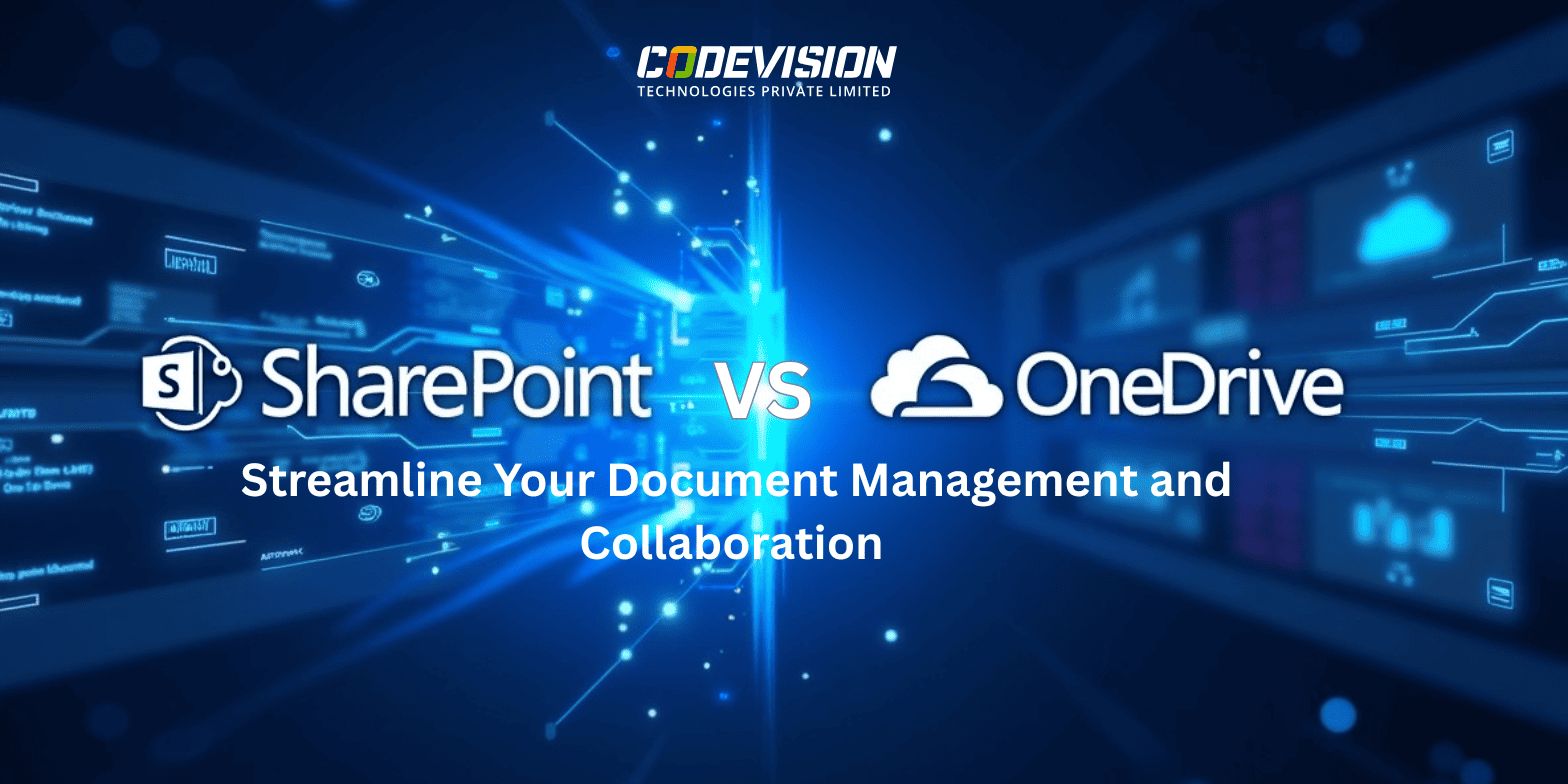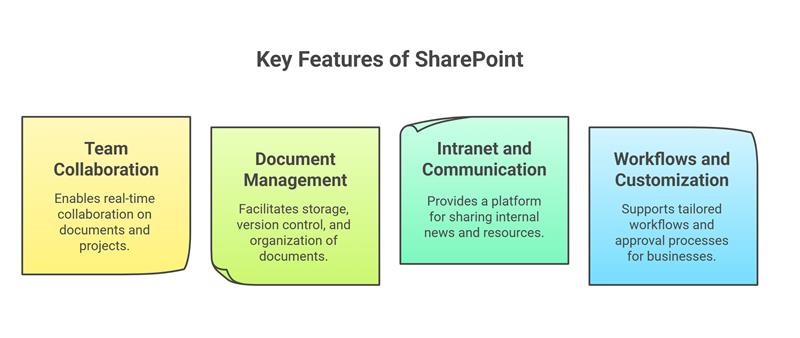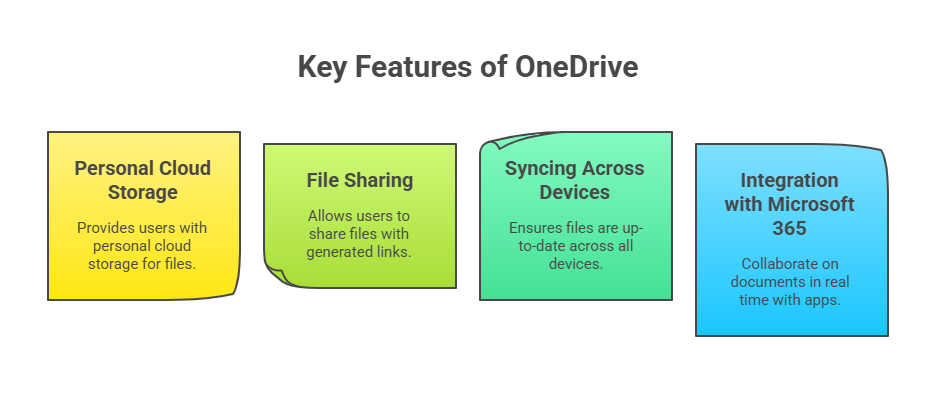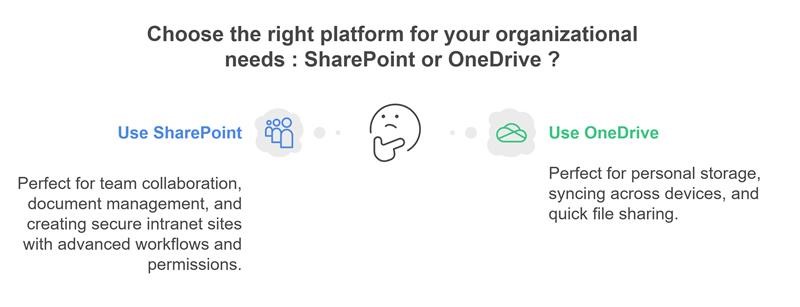SharePoint vs OneDrive: Streamline Your Document Management and Collaboration

In today’s digital age, collaboration and file storage are key components of organizational productivity. Microsoft offers two cloud-based solutions—SharePoint and OneDrive—that help businesses manage documents, share files, and collaborate more efficiently. Even though they seem similar, they serve different purposes and have unique features that make them different. Let’s break down the differences between SharePoint and OneDrive and explore when to use each one.
Understanding SharePoint and OneDrive: Essential Cloud Solutions for Your Needs
What is SharePoint?
SharePoint is a web-based collaboration platform designed for businesses to create, store, organize, and share content. It acts as a central hub for teams to work together, manage documents, and keep tasks moving. SharePoint is a great option for organizations looking for good tools to manage content, track projects, and keep operations running smoothly across teams.
Key Features of SharePoint:
- Team Collaboration: SharePoint allows teams to work together on shared documents and projects. Multiple users can collaborate on the same document simultaneously, and all changes are tracked in real-time.
- Document Management: With SharePoint, businesses can store documents, set permissions, manage document versions, and apply metadata to files for better organization.
- Intranet and Communication: SharePoint offers a powerful intranet solution where businesses can share internal news, updates, and resources with employees.
- Workflows and Customization: SharePoint allows for creating customized workflows, approval processes, and content management systems tailored to business needs.

What is OneDrive?
OneDrive is Microsoft’s personal online cloud storage that lets users to store, sync, and share files. It works well with other Microsoft 365 apps, providing users with a secure location for storing documents, photos, and videos. While OneDrive can be used to share files with others, it’s mainly made for individual storage.
Key Features of OneDrive:
- Personal Cloud Storage: OneDrive provides users with personal cloud storage to save files, photos, and videos that can be accessed from any device.
- File Sharing: OneDrive allows users to share files with others by generating links that grant access. Users can set permissions for who can view or edit the shared content.
- Syncing Across Devices: OneDrive offers automatic syncing across devices, ensuring that your files are always up-to-date and accessible, whether you’re online or offline.
- Integration with Microsoft 365: OneDrive seamlessly integrates with apps like Word, Excel, and PowerPoint, allowing you to collaborate on documents in real time.

Key Differences Between SharePoint and OneDrive: A Comparative Overview
| Key Differences | SharePoint | OneDrive |
|---|---|---|
| Purpose & Use Case | Team collaboration, content management | Personal file storage , sharing and syncing |
| Collaboration Features | Real-time collaboration, versioning | Basic file sharing, personal files |
| Document Management | Advanced libraries, workflows | Basic version history, file sharing |
| Customization | Highly customizable, team sites | Limited customization, file access |
| Security & Permissions | Granular control, user-level access | Basic file-level sharing permissions, Link password Protection |
| File Storage Capacity | Large-scale storage for teams | Personal storage, free tier (5GB) |
| Integration with Microsoft 365 | Full integration with Office apps | File syncing across devices |
| External Sharing | Controlled external sharing | Easy sharing via links or email |
| Team/Project Management | Includes team sites, project tools | For personal use, with no team-specific management features. |
When to Use SharePoint vs OneDrive: Making the Right Choice for Your Organization

Use SharePoint when:
- You need a centralized platform for team collaboration and document management.
- You want to create and manage team sites and intranet portals for sharing information across the organization.
- Your team requires advanced document management features, such as version control, workflows, and content approval processes.
- You need granular security and permissions for complex organizational needs.
Use OneDrive when:
- You need a personal cloud storage solution to store and access files on the go.
- You want to sync files across multiple devices, ensuring access to your documents offline and online.
- You need to share files with others quickly, but don’t require the advanced collaboration tools that SharePoint offers.
- You are working on individual projects and don’t need complex team-based document management features.
Conclusion
Both SharePoint and OneDrive are powerful tools in the Microsoft ecosystem, but they serve different purposes. SharePoint is the best tool for enterprise-level collaboration, content management, and workflow automation, while OneDrive is perfect for individual file storage and personal cloud access. Understanding the unique features and use cases of each platform will help you choose the right solution for your business or personal needs.
By integrating SharePoint and OneDrive into your workflow, you can leverage the strengths of both tools to improve collaboration, streamline document management, and enhance productivity.
Frequently Asked Questions
SharePoint is a web-based collaboration and content management platform designed for enterprises. It enables teams to create intranet portals, collaborate in real-time, manage documents, enforce version control, and implement customized workflows and approval processes
OneDrive serves as a personal cloud storage solution, ideal for file syncing and sharing across devices. It seamlessly works with Microsoft 365 apps and is suited for individual use — whereas SharePoint offers advanced document libraries, metadata, team sites, workflows, and enterprise-level management features
Choose SharePoint when you need centralized team collaboration, document management, intranet portals, granular security, version control, and workflow automation
Use OneDrive when you need personal cloud storage, device synchronization, easy file sharing, and integration with Microsoft 365, without the need for team-centric document management features
Yes. SharePoint is optimal for team-focused document management and workflows, while OneDrive handles personal file storage and syncing. Utilizing both allows you to leverage their combined strengths for better collaboration and productivity
Both SharePoint and OneDrive offer enterprise-grade security as part of Microsoft 365, including encryption, compliance, and data loss prevention. However, SharePoint provides more granular permission settings and access control for teams, making it better suited for organizational security needs.
No. SharePoint and OneDrive complement each other. SharePoint is designed for team collaboration, document libraries, and workflows, while OneDrive focuses on personal file storage and syncing. Most businesses use both together.
For remote or hybrid teams, SharePoint is usually better since it allows team members to collaborate on shared files, track changes, and access centralized project sites. OneDrive works well for individual remote employees who need personal file access across devices.
By default, OneDrive provides 1TB of personal storage per user (expandable with plans). SharePoint storage is shared across the organization with a base of 1TB plus 10GB per licensed user, and additional storage available for purchase.
Small businesses often start with OneDrive, as it’s affordable, easy to use, and included in Microsoft 365 subscriptions. As collaboration grows, SharePoint becomes more cost-effective for managing teams, projects, and document workflows.
Yes. Microsoft provides built-in migration tools, and third-party solutions are available to move files from OneDrive to SharePoint without losing metadata, permissions, or folder structures.
Both integrate seamlessly with Microsoft Teams. SharePoint powers the document libraries behind Teams, while OneDrive manages personal file sharing in chat. Together, they create a unified collaboration experience.
OneDrive is primarily for individual use, but it’s included in Microsoft 365 enterprise plans. While enterprises use OneDrive for personal file storage, SharePoint remains the backbone of enterprise-level collaboration and content management.
Both platforms support versioning, but SharePoint offers more advanced version history, approvals, and workflow management, making it the better option for organizations with strict document governance needs.
Yes. Both allow offline access through the OneDrive sync client. Files synced to your device can be worked on offline and changes are automatically updated when reconnected to the internet.

Microsoft 365 Copilot vs Google Gemini — The Future of AI-Powered Productivity




